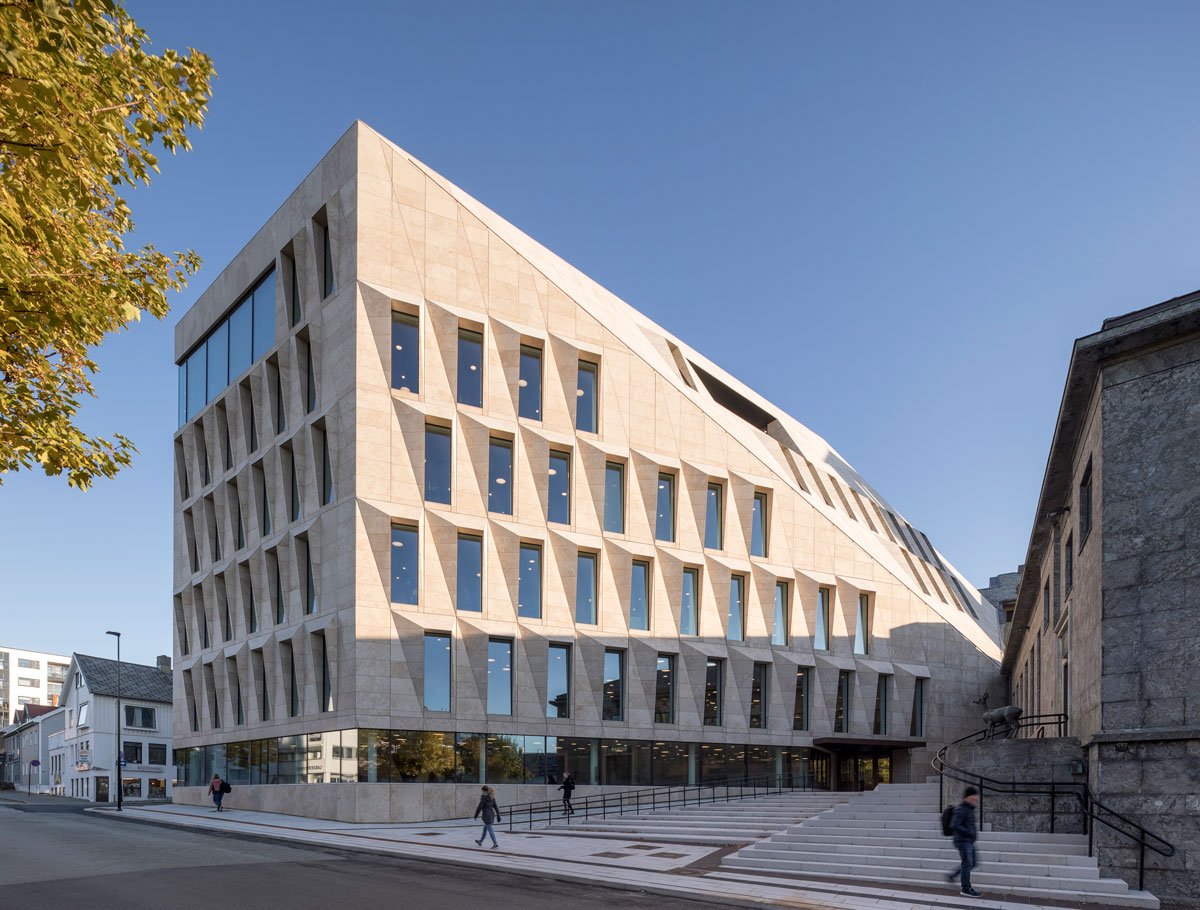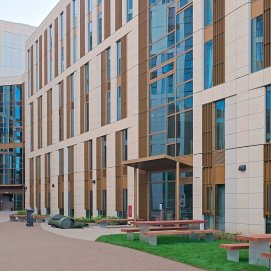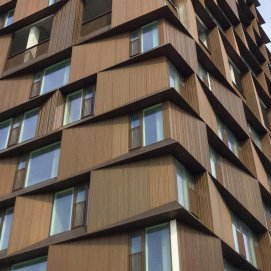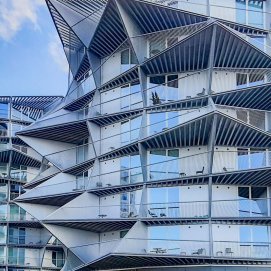Hansen UnitAl®
Hansen UnitAl is a prefabricated unitised facade system with endless design possibilities for quick closure of the building envelope.
Prefab moves hours from the building site to a controlled environment and results in significantly shorter on-site construction time.
Hansen UnitAl is a unitised facade system for quick closure of the building envelope.
Record-fast closing of facades can significantly shorten the total construction time of the building. For smaller cases, standard profiles are often used, while larger cases may include newly developed profiles, where the client and architect can make their mark on the profile geometry.
Prefabricated Unitized Facades and Optimal Planning & Logistics
In the ever-evolving world of construction, efficiency and productivity are key factors in the success of any project. Traditional construction methods often face challenges such as unpredictable weather conditions, coordination issues, and delays caused by on-site fabrication. However, the emergence of prefabricated unitized facades has revolutionized the construction industry by offering a streamlined and efficient solution to these challenges.
Prefabricated unitized facades involve the fabrication of building envelopes or curtain walls in a controlled factory environment before being transported and installed on-site as modular units. This off-site fabrication approach allows for optimal planning and logistics, leading to increased productivity and time savings throughout the construction process.
One of the significant advantages of prefabricated unitized facades is the controlled factory environment in which they are manufactured. The controlled conditions ensure high-quality fabrication with meticulous attention to detail, resulting in precise and consistent construction elements. This standardized production process minimizes errors and improves the overall quality of the final product. By reducing the likelihood of rework and modifications on-site, construction projects can maintain a smooth workflow, saving valuable time and resources.
Another crucial aspect of prefabricated unitized facades is their ability to minimize the impact of weather conditions on construction timelines. With traditional construction methods, adverse weather can cause significant delays, leading to project disruptions and cost overruns. Prefabricated unitized facades, however, are manufactured in a weather-protected environment. This means that the assembly and fabrication of the units are not subject to external factors, such as rain, wind, or extreme temperatures. As a result, construction schedules become more predictable, enabling project managers to plan and allocate resources efficiently.
Coordination between different contractors is a common challenge in construction projects. With prefabricated unitized facades, the need for coordination and sequencing of activities is significantly reduced. Since the units are manufactured off-site and delivered as complete modules, the installation process becomes more straightforward. This streamlined approach allows for better coordination among various trades and eliminates potential conflicts that may arise when multiple contractors work simultaneously on-site. Consequently, construction projects can progress smoothly, minimizing downtime and improving overall efficiency.
Several case studies highlight the positive impact of adopting prefabricated unitized facades in construction projects. For instance, in the construction of a high-rise building in a dense urban area, the use of prefabricated unitized facades allowed the project team to complete the cladding installation in record time. This accelerated timeline freed up valuable resources and enabled the allocation of additional efforts towards interior finishing and other critical aspects of the project. Similarly, in the construction of a hospital facility, the adoption of prefabricated unitized facades reduced the construction duration significantly, ensuring that the medical center could start operating and serving the community earlier than expected.
In conclusion, the integration of prefabricated unitized facades into construction projects brings numerous benefits, including enhanced efficiency, improved productivity, and time savings. The controlled factory environment ensures high-quality fabrication and reduces the impact of adverse weather conditions. Furthermore, the streamlined installation process minimizes coordination issues, allowing for better project planning and resource allocation. As the construction industry continues to evolve, prefabricated unitized facades are poised to play a pivotal role in optimizing planning and logistics, ultimately leading to more successful and efficient construction projects.
It is possible to design the modules with both transparent and infilled areas or transparent panels with glass thicknesses from 4-73 mm.
The fillings contain wind plate, insulation and a vapor seal. The transparent areas can be both fixed glazing and opening vents or a combination of both.
On the outside of the facade system, architectural elements can be built in the form of e.g. stone, aluminum cladding or sun shading.
HansenUnitAl elements are usually produced in a width of 3,000 mm for transport, while the height often corresponds to 1 or 2 times the floor height. With the right planning and execution, approx. 400 m² full finished facade per. working day.
In the event of a requirement for a reduced climate footprint, HSHansen can supply aluminum profiles produced using renewable energy sources. This special aluminum alloy reduces the CO2 emissions for the Hansen System Profiles by more than 75% compared to standard aluminum.
- Optimal and uncomplicated interfaces / contract boundaries
- Quick closed house = reduced construction time by up to 60%
- Only one contractor on the facade closure
- Fewer construction nuisances on the site, such as noise and dust
- No interim closures
- Heating during the construction period with insulated facades
- High quality - items are prefabricated at the factory under controlled conditions that are not dependent on the weather and other contractors
- No sandwich concrete elements (Smaller depth = less m² for wall / facade = larger interior area)
- Sustainable construction process - time is moved from the construction site into production
- Optimal planning & logistics for the construction project = high productivity which frees up valuable time for the client and other contractors
- Larger finish = fewer defects
- Minimum storage space on the construction site - delivery JIT
- No elastic joints on the outside
- Can record movements and difference theorems in main constructions.
- No annoying scaffolding on the building for facade installation'
- Small fitter staff- less strain on construction site and welfare facilities
- Less coordination for construction management
- Components such as solar cells, solar shading, natural stone, screen bricks, fillings can be built into the prefabricated elements from the factory
Construction
Elements span vertically between the floors. Elements are typically mounted in the top.
Design
Elevation width of the profile system is 72 mm. Profile depth between 160 and 310 mm. The system supplier HansenConcepts is ISO 9001 certified.
Profiles
The system is available in a number of profile designs, which can create different visual appearances of the facade.
Glazing range
52-71mm
Insulating zone
The profiles are insulated with a specially designed thermal break between the aluminium profiles. This breaks the cold bridge throughout the entire length of the profiles. Extra insulation of the rebate is optional. Variety: Hansen UnitAl is also found in a Structural Glazing (SG) system, where the glass is held by hidden fittings. For the visual appearance of the façade, the space between the two glass panes is jointed with silicone. Hansen UnitAl can be carried out in a flame retardant version (EI60).
Air permeability:
AE 1200
Water tightness:
RE 1200
Wind load classification:
Serviceability: 1600 Pa
Safety: 2400 Pa




